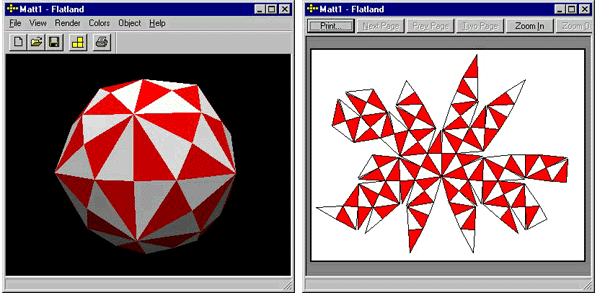Build your own PolyhedraCompiled by Paul Bourke and Matt StorzBased upon software called "Shapescape" (previously known as "Flatland") written by Matt Storz. Introduction
The following provides outlines of the faces of many polyhedra in a form suitable for printing. The outlines can then be cut, folded, and glued so as to create real models. The images are supplied in two formats, GIF and Postscript. If you have a display Postscript system or have software that can read and manipulate Postscript then that is the best format to use. Otherwise most image editors will accept GIF, indeed unless you wish to resize the model you should be able to print the GIF version directly from your browser. Table of Polyhedra
Description of Flatland by Matt Storz Flatland is a Windows program that allows various 3D shapes, polyhedra, to be created and then flattened so that a pattern can be printed to make a model of the polyhedron. program (octahedron, dodecahedron, icosahedron, etc) to start with. These polyhedra can be manipulated in various ways to produce more complicated shapes. After selecting a polyhedron, it can be rotated and viewed from every side. Pictures and colours can be applied to each face of the polyhedron. The polyhedron can then be flattened and printed out on one or more sheets of paper which can then be used as a template to cut cardboard to produce a model of the polyhedron.  Comments by others on building the models
By Matt Storz Here's how I make the models... I use Avery full sheet label paper with a color ink jet printer. I printout the model net from the flatland software, I place the labels on regular cardboard that I pick up at my local grocery store. I use an exacto knife and a metal straight edge along with a cutting mat to cut out the net. I score all of the fold lines with the exacto knife. I fold and tape all of the seams with just regular transparent tape until I can't get my hands into the inside of the polyhedron model. Then I use paper glue to connect the last seam. I've tried a few kinds of glue and the best I've found so far is the glue stick kind.. You just rub it on the two paper edges and it sticks together pretty quickly and its fairly strong too. By Simon BullenThis is what I've been doing with polyhedra constructed with plans from "Numerical Recipes":
Tips:
If you have suggestions or practical ideas on creating physical models we'd like to hear from you. |